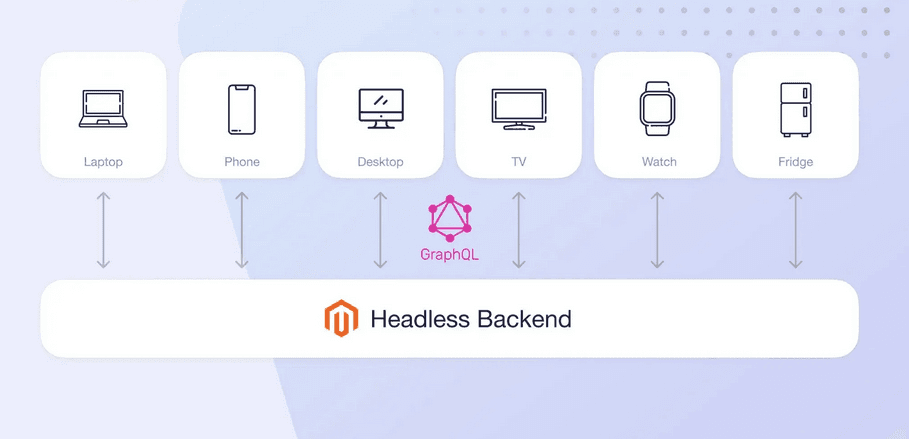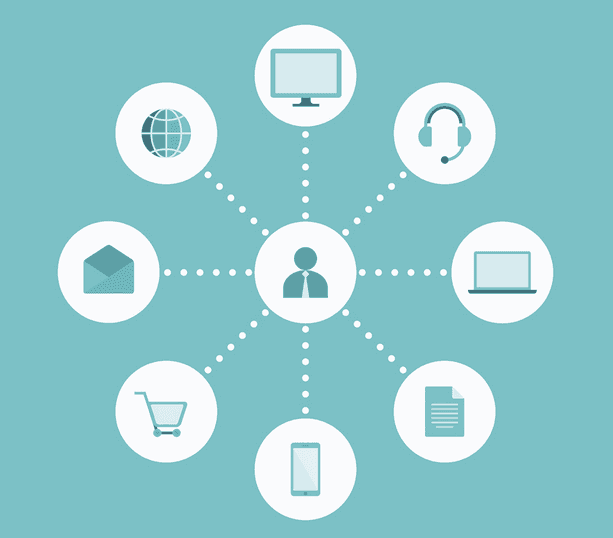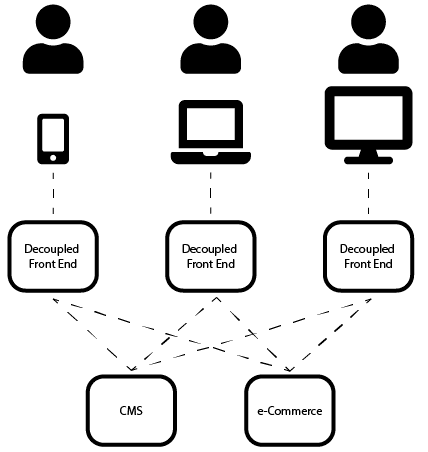Headless Magento: The Future of Ecommerce Development

You may soon have to migrate to headless Magento if you have a fast-growing ecommerce business built on the traditional Magento platform.
Customer needs are changing fast, meaning that ecommerce businesses must be agile or risk losing their market grip. Increased agility and flexibility can help businesses adapt to changing customer needs, but traditional ecommerce platforms like the monolithic Magento do little to support such agility.
So, despite its widespread adoption, the traditional Magento platform may not adequately future-proof your ecommerce business if you serve a diverse market.
In this article, we discuss the qualities and features that make headless Magento consistent with the future of ecommerce development.
Let’s dive right in.
What Is Headless Magento
Headless Magento is a new open source ecommerce software platform approach that decouples the presentation layer from the ecommerce engine in the back end.
The two separate layers of the headless Magento platform communicate through APIs (application programming interfaces).
This approach to ecommerce development involves implementing a single-backed solution and integrating it with multiple front ends. Subsequently, the front ends can be deployed as web application interfaces, mobile apps, IoT device screens, and more.
Front-end developers must configure each user interface with the right API integrations to pull data from the central back-end functionality.
This approach is a significant departure from the traditional Magento architecture that follows a monolithic design. The monolithic architecture involves a front and back end tightly integrated as a unit within the same codebase.
Separating the customer presentation layer of your Magento solution from the back end allows for greater flexibility in designing the storefronts. Chiefly, you can create user interfaces that resonate better with your business’s various customer segments.
Additionally, you can use your preferred modern front-end technology stack to develop your business’ front-end, unlike traditional Magento, which limits your customization.
Why Headless Magento is the Future of Ecommerce Development
Now that you know what constitutes a headless Magento, it’s time to examine what makes it the future of ecommerce development.
Read along.
It offers a better omnichannel experience.
You are likely familiar with Amazon and how it operates if you have not used it a few times already. The same applies to Starbucks and Disney. What do these brands have in common?
Each of them allows you to interact via mobile, web, voice, email, and digital interfaces in a connected manner.
You can initiate a product purchase on Amazon on your office desktop computer (web), stop midway, and proceed to check out on your mobile phone in the subway hours later.
Notice that you’re continuing on your mobile application a transaction that you started on a web application without repeating any process. Welcome to the world of omnichannel customer experience.
What is omnichannel customer experience?

That ability to continue your experience seamlessly as you switch from one channel to another is called omnichannel experience.
Today, it is more crucial than ever for ecommerce businesses to provide this kind of experience to shoppers as they (consumers) continue to find new ways of interacting with businesses online.
When ecommerce first surfaced, desktops were the only customer touchpoint. This made selling online more straightforward. As such, a coupled front end and back end existing as a unit was more than sufficient to handle sales and the nuances of various customers.
However, over time, customer touchpoints have increased. Shoppers can now interact with businesses on many channels, including mobile and IoT devices, not just the web alone.
With headless Magento, you can expand to more channels in more unified ways that are not possible with a traditional monolithic system.
Just a single powerful Magento back end can serve content to multiple front ends across different channels through APIs. Once you have your Magento installation, your front-end developers can create custom user interfaces for various channels to pull data from your central back end via the right API integrations.
Significantly, this method means the customer will interact with the same data regardless of the channel they use to access it.
It has more flexible customization options.
Flexibility is perhaps the biggest advantage of a headless solution such as headless Magento. This open-source platform allows you to customize it to meet various business needs. Specifically, since it comes without a presentation layer (head), you can build this customer-facing layer from scratch using your preferred front-end technology.
Being able to create your Magento storefront from scratch means you have limitless customization options to explore.
Conversely, for a traditional Magento solution with the front and back end existing in the same codebase, any changes to one layer affect the other. Any change made to the customer-facing front end invariably affects the back-end functionality.
Therefore, you require plenty of coding skills to make the slightest changes in a monolithic system. A less mindful change to the code can easily send ripples across the system in the form of bugs and errors. Correspondingly, this quality significantly limits the changes you can make to the platform.
However, having a separate presentation layer from the back-end infrastructure means you can make any tweaks without affecting the back end and vice versa.
You will find adding new technologies or testing new features on your headless Magento front end much easier without worrying about the back-end functionality.
This quality makes the business more agile and responsive to customer needs. It can go a long way in promoting innovation in your enterprise.
It lets you create storefronts with more freedom.
Suppose you are familiar with traditional Magento stores; you know that they rely on predefined themes for ecommerce development.
Subsequently, your storefront design is limited to the contents and layout of your chosen theme.
On the other hand, the headless Magento platform comes without a dedicated front end tied to the back end. This allows you the freedom to build your storefront the way you want it. You can choose the tech stack, including the frameworks and programming languages that best suit your needs.
This freedom means you can create unique user interfaces and deliver personalized experiences to your ecommerce customers.
Naturally, creating custom storefronts may take time upfront. But once they are in place, tweaking and modifying them as necessary should be quick and gratifying, thanks to the absence of these restrictions.
It offers improved speed and performance.
Performance bottlenecks are some of the challenges you may face when using traditional Magento setups. The platform has the front-end presentation layer tightly built into the back-end functionality.
This means a large volume of code to process and render whenever a user sends a request. Rendering that much code can be time-consuming, leading to slower page loads and a negative user experience.
Notice that Google recommends two seconds as the ideal page load speed for an ecommerce site. In essence, if your page takes longer to load, you will likely lose many customers to the competition. Conversions for an ecommerce store decrease by 0.3% for every extra second that the site takes to load.
Conversely, by separating the presentation layer from the back-end infrastructure, the headless Magento setup effectively reduces the amount of code the site must render every time a customer visits a page. This leads to significant increases in page load speeds while boosting website performance.
It is more scalable, ideal for future-proofing a business
The enhanced flexibility of a decoupled headless Magento architecture means that you can allocate more resources during peak times or as customer numbers increase to handle the increased demand.
The decoupled architecture allows you to scale the front end and back end of the platform independently. As a result, you can respond to surges in demand more readily by adding more resources to the respective component as soon as the need arises.
With that in mind, you can grow your business effectively without experiencing diminished performance in the future by allocating resources based on demand.
This scalability ensures that your ecommerce site can handle expanding product catalogs, growing traffic, diverse portfolios, and increased sales volumes while maintaining optimal performance.
It can reduce the total Cost of Ownership.
Maintenance and modifications are much easier once you finish creating the storefronts for your headless Magento.
If you were to make changes to any layer of a traditional monolithic platform, the modification would require extensive redesign or reimplementation involving altering the code. You must test the code with every alteration to ensure it works properly. Naturally, this requires the help of an experienced developer.
This makes it costly to maintain and modify an online store built on a monolithic platform. On the other hand, changes to a headless storefront usually don’t require developers’ input because they can occur without changing the code.
Additionally, integrating the headless ecommerce solution with third-party tools and services such as a CMS effectively reduces expenses by eliminating the need for custom development.
Therefore, with a headless Magento, you can streamline your ecommerce development process and save costs.
It allows better personalization and localization.
If you are familiar with Magento, you know it already has a content hierarchy that allows businesses to create multiple sites and storefronts to target different customer groups. This allows store owners to deliver personalized experiences.
The headless option takes personalization to a whole new level. It allows developers to build storefronts targeting different customer segments by country. Your marketing team can then use the platform’s AI-powered marketing and machine-learning capabilities to collect helpful data and deliver highly targeted content.
If you wish to expand into new markets, headless Magento can let you send localized text and visuals that drive the best responses from the target audience.
Maintaining and updating the platform can be pretty fast
Since changes in the front end do not impact the back end, and vice versa, you can easily implement necessary updates as soon as necessary. The decoupled architecture allows for independent customization and development opportunities for each side.
You can customize or modify the storefront without affecting the back-end functionalities at any point. Additionally, the headless platform allows you to seamlessly integrate your storefront with essential third-party systems and services for inventory management, marketing automation, and more.
The architecture strengthens the ecommerce store’s security
Separating the presentation layer from the core ecommerce engine in the back end goes a long way in mitigating potential attack vectors and securing the headless Magento store.
The architecture effectively isolates the back end from direct user access. So, any malicious activity or attacks on the customer-facing side of the platform do not reach the back end where sensitive data and customer information are stored.
With such enhanced security, your business can enjoy increased customer trust and safety from cyber threats and potential data breaches.
Should you adopt Headless Magento 2 in your ecommerce development?

To this point, you have gained valuable insights into headless Magento commerce’s potential benefits. But does that mean you should adopt it for your business? The correct answer is it depends.
Whether to jump aboard the Magento 2 headless bandwagon requires weighing up your circumstances. In other words, consider a Magento 2 headless solution for your ecommerce development if any of these things apply to you:
You want to improve your store’s UX and mobile performance
You plan to expand internationally
You want more flexibility and experimentation
You constantly update your content
Summary: Why Headless Magento is the Future of Ecommerce Development
In this article, we’ve learned that Headless Magento is a new approach to ecommerce development that decouples the presentation layer from the ecommerce engine in the back end. In so doing, it achieves the following things, making it ideal for future-proofing businesses:
Strengthens the ecommerce store’s security
Speeds up the process of maintaining and updating the platform
Allows better personalization and localization
Reduces the total Cost of Ownership
Offers better scalability, improved speed, and performance
Allows for the creation of storefronts with more freedom
Offers a better omnichannel experience
Going forward, we’ll continue to delve deeper into headless Magento 2 and discuss what makes it the right choice for ecommerce stores.
Want to learn more about headless Magento 2 architecture and its suitability for your ecommerce development plans? The headless Magento experts at Endertech can help. Hop into a free discovery call.
